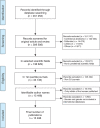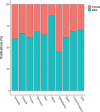Gender Disparities in Authorships and Citations in Transplantation Research
- PMID: 33134490
- PMCID: PMC7575186
- DOI: 10.1097/TXD.0000000000001072
Gender Disparities in Authorships and Citations in Transplantation Research
Abstract
Background: Over the past decades, there has been a rapid change in the gender ratio of medical doctors, whereas gender differences in academia remain apparent. In transplantation research, a field already understaffed with female doctors and researchers, there is little published data on the development in proportion, citations, and funding of female researchers over the past years.
Methods: To evaluate the academic impact of female doctors in transplantation research, we conducted a bibliometric analysis (01 January 1999 to 31 December 2018) of high-impact scientific publications, subsequent citations, and funding in this field. Web of Science data was used in combination with software R-Package "Gender," to predict gender by first names.
Results: For this study, 15 498 (36.2% female; 63.8% male) first and 13 345 (30.2% female; 69.8% male) last author gender matches were identified. An increase in the percentage of female first and last authors is seen in the period 1999-2018, with clear differences between countries (55.1% female authors in The Netherlands versus 13.1% in Japan, for example). When stratifying publications based on the number of citations, a decline was seen in the percentage of female authors, from 34.6%-30.7% in the first group (≤10 citations) to 20.8%-23.2% in the fifth group (>200 citations), for first (P < 0.001) and last (P = 0.014) authors, respectively. From all first author name-gender matches, 6574 (41.6% female; 58.4% male, P < 0.001) publications reported external funding, with 823 (35.5% female; 64.5% male, P = 0.701) reported funding by pharmaceutical companies and 1266 (36.6% female; 63.4% male, P < 0.001) reporting funding by the National Institutes of Health.
Conclusions: This is the first analysis of gender bias in scientific publications, subsequent citations, and funding in transplantation research. We show ongoing differences between male and female authors in citation rates and rewarded funding in this field. This requires an active approach to increase female representation in research reporting and funding rewarding.
Copyright © 2020 The Author(s). Transplantation Direct. Published by Wolters Kluwer Health, Inc.
Conflict of interest statement
The authors declare no conflicts of interest.
Figures




Similar articles
-
The dementia research career pipeline: Gender disparities in publication authorships and grant funding outcomes at different career stages.AMRC Open Res. 2022 Aug 10;4:18. doi: 10.12688/amrcopenres.13072.1. eCollection 2022. AMRC Open Res. 2022. PMID: 38708126 Free PMC article.
-
Sex Disparities in Ophthalmic Research: A Descriptive Bibliometric Study on Scientific Authorships.JAMA Ophthalmol. 2019 Nov 1;137(11):1223-1231. doi: 10.1001/jamaophthalmol.2019.3095. JAMA Ophthalmol. 2019. PMID: 31415074 Free PMC article.
-
Association of Author Gender With Sex Bias in Surgical Research.JAMA Surg. 2018 Jul 1;153(7):663-670. doi: 10.1001/jamasurg.2018.0040. JAMA Surg. 2018. PMID: 29590329 Free PMC article.
-
Global architecture of gestational diabetes research: density-equalizing mapping studies and gender analysis.Nutr J. 2016 Apr 4;15:36. doi: 10.1186/s12937-016-0154-0. Nutr J. 2016. PMID: 27044432 Free PMC article. Review.
-
A Bibliometric Analysis of the Most Cited Articles in Neurocritical Care Research.Neurocrit Care. 2019 Oct;31(2):365-372. doi: 10.1007/s12028-019-00731-6. Neurocrit Care. 2019. PMID: 31087256 Review.
Cited by
-
A multi-faceted approach to sex and gender equity in solid organ transplantation: The Women in Transplantation Initiative of The Transplantation Society.Front Immunol. 2022 Sep 26;13:1006855. doi: 10.3389/fimmu.2022.1006855. eCollection 2022. Front Immunol. 2022. PMID: 36263043 Free PMC article.
-
Academic medicine's glass ceiling: Author's gender in top three medical research journals impacts probability of future publication success.PLoS One. 2022 Apr 20;17(4):e0261209. doi: 10.1371/journal.pone.0261209. eCollection 2022. PLoS One. 2022. PMID: 35442998 Free PMC article.
-
Gender authorship trends in spine research publications - Research across different countries from 1976 to 2020.Brain Spine. 2022 Apr 15;2:100889. doi: 10.1016/j.bas.2022.100889. eCollection 2022. Brain Spine. 2022. PMID: 36248135 Free PMC article.
-
Overcoming citation bias is necessary for true inclusivity in Plant Science.Plant Cell. 2023 Dec 21;36(1):10-13. doi: 10.1093/plcell/koad248. Plant Cell. 2023. PMID: 37742058 Free PMC article. No abstract available.
-
Diversity Drives Representation: An Internal Audit of Gender Representation in Citation Practices of a Single Surgical Laboratory.Plast Reconstr Surg Glob Open. 2024 Jun 14;12(6):e5823. doi: 10.1097/GOX.0000000000005823. eCollection 2024 Jun. Plast Reconstr Surg Glob Open. 2024. PMID: 38881963 Free PMC article.
References
-
- Jagsi R, Silver JK. Gender differences in research reporting. BMJ. 2019; 367:l6692.doi: 10.1136/bmj.l6692 - PubMed
-
- Jagsi R, Guancial EA, Worobey CC, et al. The “gender gap” in authorship of academic medical literature—a 35-year perspective. N Engl J Med. 2006; 355:281–287 - PubMed
-
- Witteman HO, Hendricks M, Straus S, et al. Are gender gaps due to evaluations of the applicant or the science? A natural experiment at a national funding agency. Lancet. 2019; 393:531–540 - PubMed
-
- Larivière V, Ni C, Gingras Y, et al. Global gender disparities in science. Nature. 2013; 504:211–213 - PubMed
Publication types
LinkOut - more resources
Full Text Sources
Miscellaneous

